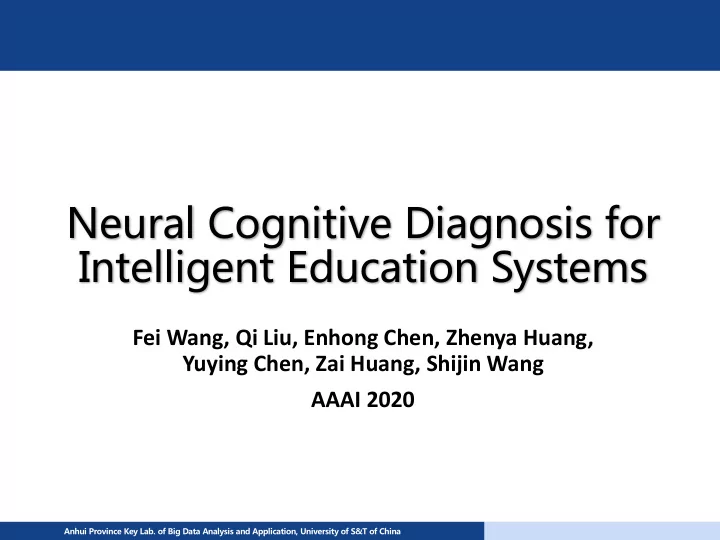

Neural Cognitive Diagnosis for Intelligent Education Systems Fei Wang, Qi Liu, Enhong Chen, Zhenya Huang, Yuying Chen, Zai Huang, Shijin Wang AAAI 2020 Anhui Province Key Lab. of Big Data Analysis and Application, University of S&T of China
Background n Cognitive Diagnosis : A fundamental task in many scenarios, especially intelligent education
Traditional Works n IRT, MIRT : scalar or latent vectors for students and exercises; logistic- like interaction function 1 ! " #$ = 1 ' # , ) $ , * $ = 1 + exp(−1.7) $ ' # − * $ ) Skill proficiency Discrimination Difficulty n difficulty, discrimination, ability n DINA : binary vectors for students and exercises; conjunctive assumption in interaction function 5 ) 8 9: ; 5 <=8 9: ! " 45 = 1 6 4 = (1 − 7 Guess Skill proficiency vector Slip n Q-matrix n MF : latent vectors for students and exercises; inner productive interaction function ! " #$ = 1 ' # , * $ = ' # > * $
l Problems in the interaction functions: l manually designed à labor intensive l mostly linear à limited approximation ability l simplistic assumptions à restricted scope of applications It is urgent to find an automatic way to learn the complex interactions for cognitive diagnosis. Learn the interaction function with neural network from data 1 ! " #$ = 1 ' # , ) $ , * $ , + $ = , ' # , ) $ , * $ , + $ = 1 + . /0.23 4 5 6 /7 4
Challenges n Black-box nature of neural network n difficult to get explainable diagnosis results ? n Leverage rich exercise text information n difficult for traditional non-neural functions n worthy of exploring with the strong ability of neural network Information
NeuralCD Framework n Student Factors : knowledge proficiency vector ! " n Exercise Factors : knowledge relevancy vector ! #$ n other exercise factors ! %&'() (optional): e.g., difficulty, discrimination n Interaction Function : interactive multi layers n Output : the probability that the student would correctly answer the exercise
NeuralCD Framework n Explainable n ! " ∘ ! $% : attach each entry of & ' Proficiency & ' to a specific knowledge concept Relevancy & *+ n Monotonicity Assumption : The probability of correct response to the exercise is monotonically increasing at any dimension of the student’s knowledge proficiency. (widely applicable) Educational psychological assumption Correct Exercise ( Knowledge ) P(Correct)=0.3 Too low! ' ↑ Optimization algorithm & *
NeuralCDM n Feasible and effective – basic implementation with Q-matrix input layer: ! " ∘ (% & − % ()** )×ℎ ()&. / 01 ∘ / & Directly from Q-matrix
NeuralCDM n Feasible and effective – basic implementation with Q-matrix interaction layer: • full connection • positive weights Monotonicity Assumption
NeuralCDM n Feasible and effective – basic implementation with Q-matrix output layer:
Generality of NeuralCD n NeuralCD framework is general and can cover some traditional models n e.g., IRT, MIRT, MF Fix Multidimensional degraded to to 1 unidimensional Multi-layer degraded to a single Sigmoid
Generality of NeuralCD n NeuralCD framework is general and can cover some traditional models n e.g., IRT, MIRT, MF NeuralCD MIRT Multi-layer degraded to a Fix to 1 summation and a single Sigmoid Where Q is learned instead of labeled by experts. There is no explicit meaning of each dimension in Q.
NeuralCDM+ n Extendible – refine Q-matrix with exercise texts n pre-train a CNN to predict knowledge concepts of the input exercise n combine with Q-matrix through a partial order probabilistic scheme: knowledge relevancy: Q-matrix >= predicted > other = 0 预测知识点 预测知识点 优化后的 ! "# 优化后的 原来的 ! "# 原来的
Experiments n Datasets n Math : Zhixue 1 , mathematical exercises (with texts) and logs n ASSIST : Assistment 2 , mathematical exercises (without texts) and logs n Student performance prediction Best 1 Private dataset, provided by iFLYTEK Co., Ltd. 2 https://sites.google.com/site/assistmentsdata/home/assistment-2009-2010-data/skill-builder-data-2009-2010
Experiments n Model interpretation n If student ! has a better mastery on knowledge concept " than student # , then ! is more likely to answer exercises related to " correctly than # . Higher DOA: students who perform well on certain knowledge concept get higher diagnosed knowledge proficiency
Experiments n Case study n a student’s performance on Q-matrix Logs 3 exercise in ASSIST n and his/her diagnosed result The student is more likely to response correctly when his/her proficiency satisfies the requirement of the exercise. Exercise Knowledge Difficulty (points) Student Knowledge Proficiency (bars)
Conclusion n We propose a neural cognitive diagnostic framework: NeuralCD n student and exercise factors, neural network interaction layers n monotonicity assumption n Feasibility: NeuralCDM with Q-matrix n Extendibility: NeuralCDM+ with refined Q-matrix that leverages exercise texts n Generality: covers some traditional models n Effective and explainable: experiments on two real-world datasets Code for NeuralCDM is available at https://github.com/bigdata-ustc/NeuralCD
Thank you for listening Q & A
Recommend
More recommend